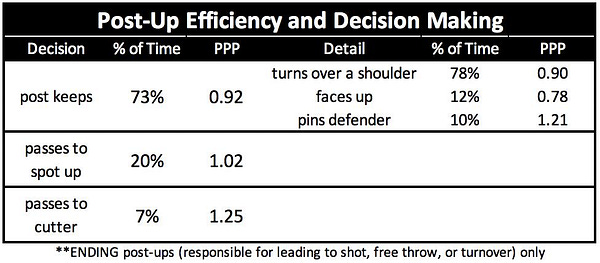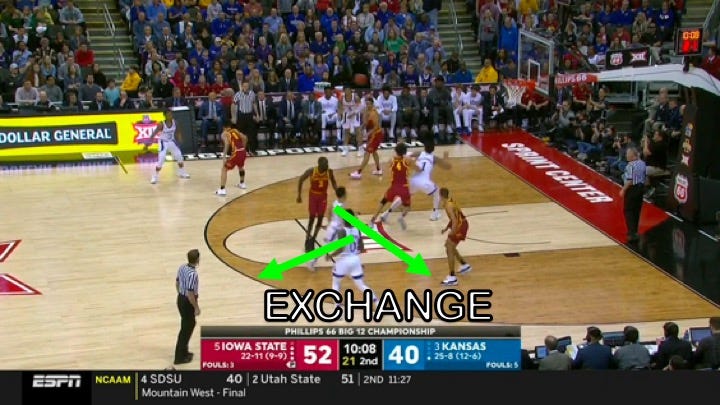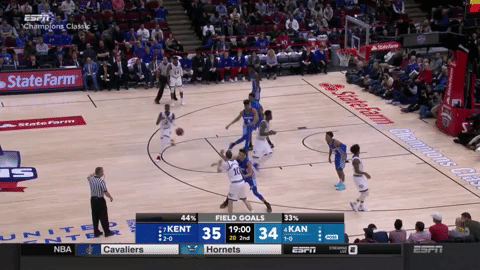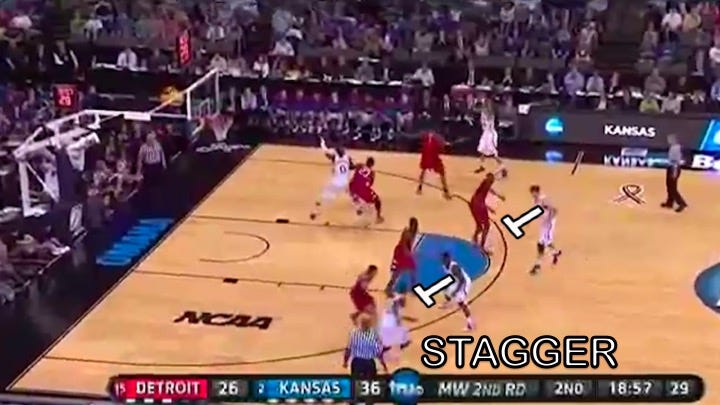This week’s edition expands on a key concept from last week, including…
Continued discussion of the post-up offense and its nuances
A breakdown of one of the nation’s most effective and successful offenses over the past decade — including some brief film and screen capture of set plays
A cameo from a former All-American
Some links and material you may have missed over the past few days
Post-up efficiency
In last week’s Mailbag Q&A, we covered some of the nuances of post-ups, eventually leading to this tweet on post-up data from the 2018-19 season:


There are a few different ways to be efficient in post-up situations. A trendy one is to use it to generate off-ball movement for cuts and spot-ups. Belmont and Nick Muszynski were one of the best at that last season. Split cuts — popularized recently by the Golden State Warriors — have become increasingly common in the college game, as well.
While having effective shooters and a good post passer is certainly a good start to an efficient offense, it’s not the type of posting up we are going to focus on in this newsletter.
Instead, we’ll focus on the “pins defender” line of the chart above. As the data explains, this type of post shot — among those where the post man keeps the ball — is the most efficient type of post shot…but it’s also the least frequent.
The idea of these post-ups are for the post man to use a combination of strength, size, angles, and misdirection to generate easy baskets. As is the case for a lot of basketball terminology, there are slightly different — but largely synonymous terms — used to describe this type of action; among them — pin, seal, duck-in.
Among head coaches, Bill Self has become the coach whose offense is most highly associated with an offense built upon the post pin.
In recent years, guard-heavy personnel has forced him to switch things up. But there’s a decent chance Self and his Kansas team will place a renewed emphasis on the post pin this season, with the return Udoka Azubuike and Silvio De Sousa.
In order to be successful with post pins, the details matter, and Bill Self-led teams thrive on detail. Everything is calculated and planned in the typical Self offensive set. Generally, these sets are less about reading the defense and more about simply executing the offense with precision and timing.
There are two main concepts Kansas has used to increase post efficiency (and post pin volume):
Occupying help defenders
Doing your work early
Occupying help defenders
Guarding the post (or any action, for that matter) is a team effort.
There’s a coaching adage that the first line of post defense is ball pressure, but the weakside defenders certainly matter, too — especially when the player guarding the post is fronting or three-quarters.
Kansas has employed many different tactics over the years to occupy help defenders, but their typical action is a stagger screen on the weakside.
The stagger screens being set in the photo above are automatically triggered when the ball gets thrown to the wing. You can see how the whole paint is now cleared out for Thomas Robinson to seal his man. That type of space and freedom may take an offense from a typical 0.90 PPP post feed to upwards of 1.20 PPP, or higher.
Another way Self and his offenses frequently occupy help defenders is through constant exchanges on the weakside. Here you can see Devon Dotson and Marcus Garrett exchanging as the ball is in the air to Dedric Lawson.

The reason such a subtle movement like a weakside exchange can have such a large impact on a play is due to the principles of help defense. Normally, the “lowest” defender on the court has help responsibilities.
Marcus Garrett was originally in the weakside corner, so his man (Tyrese Haliburton) is the low man. But the exchange obfuscates that responsibility. With Dotson headed to the corner, Marial Shayok is eventually going to become the low man instead.
The ideal defensive coverage here would be to switch. Shayok would stay high and guard Garrett. Haliburton would stay low and help on the post entry. But that switch has to be communicated quickly and effectively, and while Haliburton and Shayok were talking it out, Lawson scored.
#DoYourWorkEarly
In the section above, we can see the impact that secondary players — e.g. those not directly involved in the post-up — can have on offensive efficiency in a post-up situation. When it comes to the man in the post, that commitment to the execution of subtle details is even more important.
When I tweeted out some of the different plays Kansas has used over the past ten seasons for post pins, here was the response from one of Bill Self’s former stars:


That’s (presumably) the terminology which Self uses with his bigs to clear space and initiate an angle for the post entry. The #DoYourWorkEarly hashtag is the perfect encapsulation of the post pin framework Kansas uses.
It’s difficult to be extremely efficient in post-ups when a player catches away from the hoop with a defender behind him. Instead, the idea is to “do you work early” to enable a catch in a scoring area.
Kansas achieves this by not only drilling their bigs on technique (“Hip 2 Hip and Leg Whips”), but also with their scheme.
Here’s a segment from a frequent Bill Self / Kansas play. Watch how Lagerald Vick pass fakes to his left before throwing back to his right.

Udoka Azubuike knows the whole time that the ball is coming back to the right side of the court. As Devonte’ Graham receives the pass, Azubuike is gearing up to pin Nick Richards at an angle.
The image below shows the same exact play as above. In each case, you can see the defender’s body and vision are facing the wrong way.

Preventing a player as massive as Azubuike from clearing space near the basket is a tough task on its own; combine that with the misdirection of the play (and maybe even some weakside movement) and you’ve captured the difficulties of guarding a Bill Self play.
Here’s one last example of the play where, thanks to an unusual camera angle, you can really see Landen Lucas leg whip his man away from the basket. Lucas wasn’t the most talented big that’s played for Self, but he executed his pins at a high level.

For extra Kansas video on all of the concepts in this newsletter click/tap here.
ICYMI earlier this week
Matthew Harris used some of the “quantifying defense” ideas from previous newsletters in a great article on Missouri and Cuonzo Martin
Ken Pomeroy debuted his program rankings; after you find your program/favorite team, be sure to read Ken’s methodology and formula for the rankings
UNC slice screen-the-screener after inbounds and pin stagger in their secondary break
Were you forwarded this email by a friend, colleague or coach? If you enjoyed it and would like to receive original research, insider access, and strategic analysis of college basketball on a regular basis, please tap/click the button below to subscribe to Hoop Vision Weekly.



